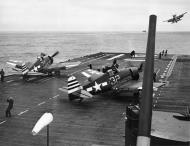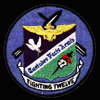Grumman F6F-3 Hellcat VF-12 White 99 named 'Sally Darlin'
flown by Commander Joseph C. Clifton USS Saratoga 1944
Flickr aeroman3
Grumman F6F-5 Hellcat VF-12 'White 9' which was flown by first Hellcat ace, Hamilton 'One Slug' Mc Whorter III and operated CV-15 USS Randolph CVG-12 1945
After completing his tour with VF-9 in March, 1944, Hamilton 'Mac' McWhorter was attached to VF-12 flying off CV-15 USS Randolph. His experiences were taken advantage of here, for the unit's transition from the F4U Corsair to the F6F Hellcat. One of the operations in which he took part with this unit were the first attacks made by carrier planes against Tokyo on February 16, 1945. During this mission, he gained another victory. About a month later, on the morning of May 15, 1945, he flew a cover mission for Task Force 58 and downed his twelfth and final kill. VF-12, with McWhorter, left the combat area in June, 1945. McWhorter stayed in the US Navy until his retirement in 1969.
Po ukončení operační túry u VF-9 v březnu 1944, byl Hamilton "Mac" McWhorter zařazen k VF-12, působící z paluby USS Randolph. Měl zde, vzhledem ke svým zkušenostem, pomoci s přechodem jejích pilotů z typu F4U Corsair na typ F6F Hellcat. Jednou z operací, jíž se s touto jednotkou zúčastnil, byl i první útok palubních letounů na Tokio 16. února 1945. Během této akce dosáhl svého dalšího vítězství. Přibližně o měsíc později, ráno 13. 5.1945, u ní získal, během bojové hlídky nad plavidly Task Force 58, i své dvanácté a poslední vítězství. VF-12 spolu s McWhorterem opustila bojovou oblast v červnu 1945. McWhorter pokračoval ve službě uUSNAVYaž do odchodu do výslužby v roce 1969.
Additional Information Eduard plastic models - http://www.eduard.com/
Grumman F6F-5 Hellcat VF-12 White 32 and operated from CV-15 USS Randolph 1945
This aircraft from Carrier Air Group 12 was photographed onboard the CV-15 USS Randolph. The white geometric identification symbols (so-called 'G symbols') were introduced on the 27th of January, 1945, to standardize the variety of carrier air group markings. The symbols identified the parent carrier. However these markings proved to be hard to remember and difficult to describe on the radio. Therefore a new identification system consisting of one or two letters was ordered on July 27th, 1945. The Randolph took part in combat against Japan from February 10th, 1945 when it participated in an attack on the Tokyo area – the first aircraft carrier attack on the Japanese homeland since the famous Doolittle raid in 1942. On March 11th, she was hit by a Kamikaze while in Ulithi. Within a few days, she was back in service and fought against the Japanese until the end of WW2.
Tento letoun by vyfotografován na palubì letadlové lodi Randolph (CV-15). Výrazné bílé zbarvení svislé ocasní plochy a køidélek bylo rozpoznávacím znakem letadel z paluby Randolphu. Tyto geometrické obrazce, zvané G-symbols, byly oficiálnì zavedeny 27. ledna 1945 a používaly se až do 27. èervence 1945. Poté byly nahrazeny jednoèi dvoupísmenným kódem. Dùvodem zmìny byla obtížná zapamatovatelnost a sdìlitelnost prostøednictvím vysílaèky. Randolph se úèastnil bojù proti Japonsku od 10. února 1945, kdy se stal souèástí útoku na Tokyo – provního útoku na japonské mateøské ostrovy vedeného z palub letadlových lodí od památného náletu bombardérù plk. Doolittla v roce 1942. Dne 11. bøezna byl v kotvišti v Ulithi zasažen letounem kamikaze. Bìhem nìkolika dní se však zapojil zpìt do váleèného úsilí, kde setrval až do konce války.
Bibliography:
- Barrett Tillman, Hellcat: The F6F in World War II, Naval Institute Press, 1979
- David McCampbell article from National Aviation Hall of Fame website
- Edward Sims, Greatest Fighter Missions, Harper and Brothers, 1962 - This sequel includes U.S. Navy and Marine Corps pilots
- Barrett Tillman, Hellcat Aces of World War 2, Osprey
Magazine References: +
- Airfix Magazines (English) - http://www.airfix.com/
- Avions (French) - http://www.aerostories.org/~aerobiblio/rubrique10.html
- FlyPast (English) - http://www.flypast.com/
- Flugzeug Publikations GmbH (German) - http://vdmedien.com/flugzeug-publikations-gmbh-hersteller_verlag-vdm-heinz-nickel-33.html
- Flugzeug Classic (German) - http://www.flugzeugclassic.de/
- Klassiker (German) - http://shop.flugrevue.de/abo/klassiker-der-luftfahrt
- Le Fana de L'Aviation (French) - http://boutique.editions-lariviere.fr/site/abonnement-le-fana-de-l-aviation-626-4-6.html
- Le Fana de L'Aviation (French) - http://www.pdfmagazines.org/tags/Le+Fana+De+L+Aviation/
- Osprey (English) - http://www.ospreypublishing.com/
- Revi Magazines (Czech) - http://www.revi.cz/
Web References: +
- History of RAF Organisation: http://www.rafweb.org
- http://en.wikipedia.org/wiki/F4U Corsair
- http://warbirdregistry.org/corsairregistry/corsairregistry.html
- Wikipedia, the free encyclopedia: http://en.wikipedia.org/
- http://www.intrepidmuseum.org/ Intrepid Sea-Air-Space Museum New York NY
- http://www.airzoo.org/ Kalamazoo Aviation History Museum Kalamazoo MI
- http://www.lsfm.org/aircraft/hellcat.htm Lone Star Flight Museum Galveston TX
- http://www.nasm.si.edu/nasm/aero/aircraft/grumman_f6f.htmNational Air and Space Museum Washington DC
- http://www.naval-air.org/ National Museum of Naval Aviation AS Pensacola FL
- http://www.neam.org/ New England Air Museum Windsor Locks CT
- http://www.planesoffame.org Planes of Fame Air Museum Eden Prairie MN
- http://users.ids.net/~qam/qam/ Quonset Air Museum North Kingston RI
- http://www.aerospacemuseum.org/ San Diego Aerospace Museum North Kingston RI
- http://www.planesoffame.org/ The Air Museum Planes of Fame Chino CA
 Editor for Asisbiz: Matthew Laird Acred
Editor for Asisbiz: Matthew Laird Acred
If you love our website please add a like on facebook
Please donate so we can make this site even better !!






























 USN Fighting Squadron VF-12
USN Fighting Squadron VF-12